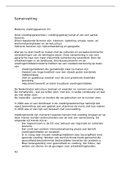Samenvatting
Summary Ch 4 Long- and Short-Term Financial Planning - Corporate Finance (COF) (AIF) - Principles of Managerial Finance
- Vak
- COF
- Instelling
- Hanzehogeschool Groningen (Hanze)
Provides in-depth summary of chapter 4. topics include depreciation methods (straight-line, double-declining balance - MACRS), Cash Flow Statement (cash inflows and outflows), cash budget, sales forecast
[Meer zien]













